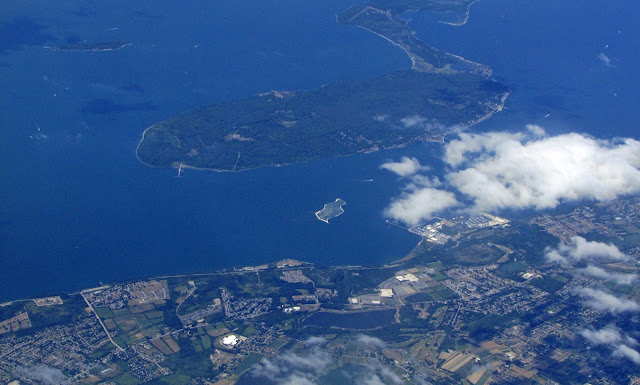This article is copyrighted. Copying, even to your genealogy pages, is prohibited by US and international law. You may "share" it with the URL link because it preserves the author's copyright notice and the source of the article.
 |
| Flying into Boston over the harbor. Logan International Airport is built on an island and landfill. |
Dyer monument!
I've returned with all kinds of resources to share with you, and I was able to meet with some important people who are excited about creating a monument to Mary and William Dyer in Newport. There's nothing firm yet, as it's just begun and will be a multi-year project, but there is an opportunity for a Dyer monument placement in Newport. When it's time to combine financial resources of corporate sponsors, city government, crowdsourcing, and private donors, you'll be a much-needed component, and when it's time for the grand opening or unveiling, you'll have plenty of notice to plan your travel and vacation time to be there for those events and much more.
Wonking out on 17th-century history
Apart from group activities, I also was able to revisit the Mary Dyer statue at the Statehouse, but missed visiting a couple of other points I wanted to see. I "hiked" in the 95/90 heat and humidity to the King's Chapel Burying Ground to find the grave of Gov. John Winthrop and Rev. John Cotton, and accidentally found an ancestor's headstone there (that's my kind of Pokemon Go). I also visited Plimoth Plantation (1624 English and Wampanoag villages) as the guest of culinary historian Kathleen Wall, who treated me to 17th century Pilgrim and Native American foods for lunch.
I'm grateful to friends (and even strangers!) who contributed to my GoFundMe campaign to pay my trip expenses. My event at Harvard University was changed to a professional video shoot there, and that means more people will have access to the Dyer story.
During my time in Rhode Island, I walked in the steps of the Dyers, 375 years ago, visiting Dyer Point/Battery Park, the area on the west coast where their farm was and where they were buried, the Portsmouth Founders Brook Park where they lived in 1638, the cemetery where Charles Dyer (their youngest son) is buried, the White Horse Tavern where William almost surely drank a pint in the 1670s, and taking an 80-foot sailboat ride out on Narragansett Bay. I visited the Newport Historical Society and viewed two documents in William Dyer's handwriting, and ordered a copy of a deed on which Mary Dyer's signature appears.
My hosts, who were friends of friends, and now are my friends, live in a beautiful home in the "boot" of Newport (see maps below). I went to sleep with a lightning show in the guest room windows and awoke refreshed with a view of a pond, a marsh with birdsong and tiny frogs, and the Atlantic Ocean breaking on the rocks nearby. They treated me like a celebrity, and helped with networking for the monument project.
I gave an author talk at the Middletown Barnes & Noble Booksellers, and met Suegray Fitzpatrick, a jewelry designer, from whom I purchased a necklace pendant of an anchor with the word "hope" that is similar to the Rhode Island state seal that William Dyer presented to the colonial assembly in 1648--and is still in use on the Rhode Island flag and seal today. I even flew into and out of Boston Harbor, as the Dyers did in ocean-going ships (see photo above).
| Sailing on Narragansett Bay, with the Dyer farm far behind, in the center of the photo. |
A short YouTube video of the tide coming in on Narragansett Bay, at Dyer Island: https://www.youtube.com/watch?v=Tq4-RFz6ckY
Christy K Robinson is the author of these books:
- We Shall Be Changed (2010)
- Mary Dyer Illuminated (2013)
- Mary Dyer: For Such a Time as This (2014)
- The Dyers of London, Boston, & Newport (2014)
- Effigy Hunter (2015)






